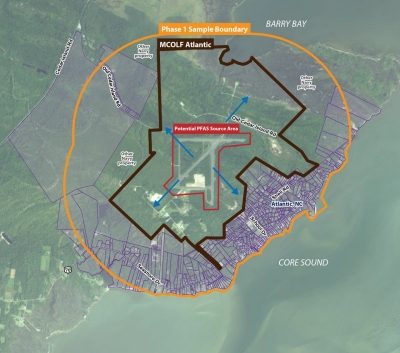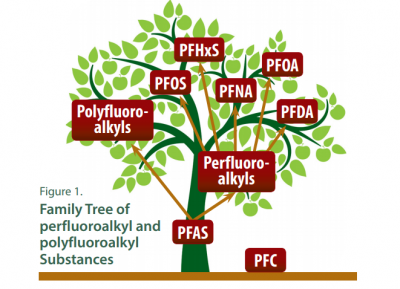
ATLANTIC – Drinking water samples from 26 private wells near the Marine Corps’ outlying landing field in this Down East Carteret County community have detectable levels of man-made compounds described as emerging contaminants, but only two of the wells sampled so far have tested at amounts at or above federal health recommendations for a lifetime of exposure.
The sampling is part of an ongoing Navy investigation into whether property owners near Atlantic Field have been exposed to per- and polyfluoroalkyl substances, or PFAS, in their drinking water and to identify potential sources of the contaminants. The Navy has tested 223 wells in the area around the airfield since November when the investigation began.
Supporter Spotlight

Navy officials hosted an informational meeting Feb. 21 in the school gym at Atlantic Elementary to share the results of the investigation, which they stressed is in its preliminary stage. Officials are also encouraging more property owners in the area to volunteer to have their well water tested for the contaminants, which share similarities with the compound known as GenX that has been detected in the Cape Fear River near Wilmington and elsewhere around the Chemours Co. manufacturing plant in Bladen County.
“Aircraft firefighting foam is one of the things that these compounds have been used in,” said Mike Barton, director of public affairs at Marine Corps Air Station Cherry Point. “They’ve been commonly used in commercial products since the 1950s, including things like Teflon and a lot of different products out there. The Navy is conducting this investigation to determine if our airfield has introduced any of these compounds into the local water. They’re doing this all over the country at different airfields.”
Permission Needed
Barton noted that the community gets its drinking water from private wells rather than a municipal system, but permission from homeowners is needed to allow sampling to determine if any PFAS compounds can be detected. A similar, initial meeting was held here Nov. 8.
“This is not something we’re required to do, but the Navy is just trying to get ahead of it now to make sure that we’re looking out for our neighbors because we’ve always been close neighbors and they’ve always been good neighbors to us out here,” he said.
Emerging contaminants are compounds that have no Safe Drinking Water Act regulatory standards or routine water quality testing requirements. The Environmental Protection Agency is studying PFAS to determine whether regulation is needed. The EPA in May 2016 released lifetime health advisory levels for two PFAS, perfluorooctane sulfonate, or PFOS, and perfluorooctanoic acid, or PFOA. The advisory levels aren’t regulatory standards but are supposed to provide a margin of protection from adverse health effects resulting from exposure to PFOS and PFOA in drinking water.
Supporter Spotlight
Officials have not determined whether Atlantic Field is a source for the compounds, but since Navy scientists determined that aircraft firefighting foam had contained them, new, safer foams are being developed.

There are no reported releases of aqueous film forming foam, or AFFF, at Atlantic Field, and no PFAS were detected in drinking water supply samples taken here in September 2016, but officials said that doesn’t mean groundwater hasn’t been affected by past operations.
The two samples from private wells in the area around the airfield that showed levels of PFAS that exceeded the EPA’s health advisory of 70 parts per trillion were not identified in order to protect the property owners’ privacy, Barton said.
The Navy is trying to sample as many wells as possible. There are more than 600 drinking water wells in the community, but officials are unsure how many are in use.
“We don’t know how many of them are being used because some of them are sitting on properties where there’s not even a house,” Barton said.
For households where sampling shows levels above the lifetime health advisory, the Navy is dispatching within 24 hours a team to contact the property owners and let them know and arrange delivery of bottled water as soon as possible. If levels are below the advisory, the policy calls for no further action.
The investigation and response could take several years, depending on complexity of any contamination found, officials said.
Health Risks
Sue Casteel, a health educator with the U.S. Department of Health and Human Service’s Agency for Toxic Substances and Disease Registry in Atlanta, said drinking water in the Atlantic community is being tested for PFOA and PFAS, which are both common compounds that can come from numerous sources.

Scientists believe that these compounds can cause increased cholesterol levels, affect hormone levels, increase the risk of certain types of cancer, decrease fertility, cause immune system changes and can affect fetuses and the children of nursing mothers. Exposure can come from contaminated food, water and soil and breathing air that contains contaminated dust. Levels can build up in the body until exposure stops. Blood tests don’t provide clear answers for possible health effects and are not a routine screening that health care providers offer.
These compounds, which don’t occur naturally, can last a long time in the environment and can be found in people, animals and fish around the world. In addition to aircraft firefighting foam and non-stick cookware, they can be found in paints and stains, water-repelling fabrics, stain-resistant carpets and food packaging.
“The good news in all this is that the PFAS levels in people are dropping all the time because a lot of PFAS-containing products have been taken off the market,” Casteel said.

Molecules in all PFAS chemicals contain carbon and fluorine atoms. Some also include oxygen, hydrogen, sulfur or nitrogen atoms. The PFAS used in the firefighting foam is composed of a longer chain of carbon atoms in the molecule, compared to GenX’s shorter chain, Casteel said.
“They’re both under the PFAS group of chemicals but right now we know a lot more about the long-chain PFAS substances and how they affect health. We don’t know as much about the shorter chains,” she said.
PFAS and perfluorononanoic acid, or PFOA, substances have been around longer, she said.
C8, the compound in Teflon that GenX replaced, is an example of a PFOA with eight carbon atoms, hence the name.
Get Your Water Sampled
The sampling period was to continue in the Atlantic community through March 1, but officials said more time may be provided as necessary. The sampling takes less than an hour and an adult resident, 18 or older, must be present. Results are expected in March.
To schedule an appointment for sampling a drinking water well in Atlantic, contact NavyAtlanticWater@usmc.mil or call 1-877-626-5317.







